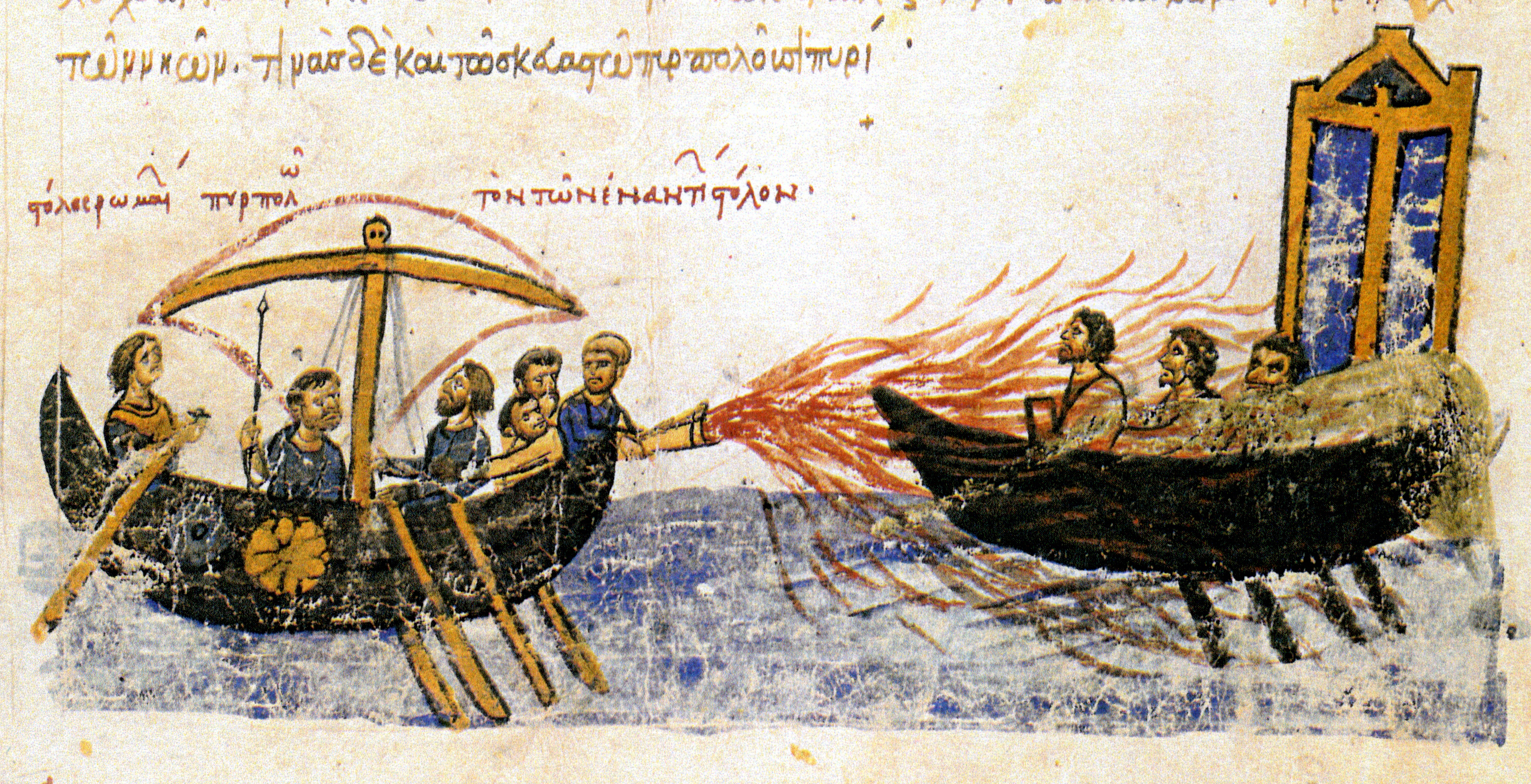While discussions of incendiary devices in pre-modern times usually begin and end with the Byzantines and Greek Fire, the use of fire dates to Biblical times. Bronze age armies of the middle east and eastern Mediterranean figured out how to take the pitch or oil from naturally occurring wells and turn it into a weapon capable of being thrown by hand or hurled by catapult. The Byzantines deserve credit for weaponizing available fuel sources into something more potent. In the mid-eighth century, the eastern Roman Empire looked as if it would soon go the way of the western half. It was beset on its frontiers, from the Arabs to the south and Bulgars to the north. Drawing on ancient Greek records and scientific tradition, Byzantine alchemists developed Greek Fire. Primarily a naval weapon, special fire ships were fitted with tanks of fuel and pumps that could spray Greek Fire at enemy ships.
 By all accounts, it was a fearsome device. Supposedly, it ignited on contact with water and could not be extinguished. In reality, some sort of primer or pilot light ignited the fuel, and it only appeared to ignite on contact with the sea, but it would certainly burn on water making it a devastating naval weapon. It could only be put out by smothering. Byzantine fire crews kept sand and vinegar on hand in case of accidental fire.
By all accounts, it was a fearsome device. Supposedly, it ignited on contact with water and could not be extinguished. In reality, some sort of primer or pilot light ignited the fuel, and it only appeared to ignite on contact with the sea, but it would certainly burn on water making it a devastating naval weapon. It could only be put out by smothering. Byzantine fire crews kept sand and vinegar on hand in case of accidental fire.
Its exact composition was a state secret. The liquid mixture was produced by very few (a single family by one account) and the troops who used it knew nothing of its preparation. A similar level of secrecy also applied to the working of the projection device. An infantry version of the pump/flame thrower device was also used with mixed results. It could be clumsy and slow. Once, the Bulgars managed to capture some of the Greek fire, but were unable to operate the equipment.
Sometime in the mid-tenth century, the armies of the Caliphate also began using a similar pump/siphon device that was handheld, in the fashion of the Byzantine device. Whether this was a result of reverse engineering of the Byzantine invention or the outright acquisition is not known. Incendiaries were devastatingly effective against Crusader siege engines. Saladin's use of naffata troops is well documented. Saladin sent troops armed with Naphta grenades against houses and civilians during an uprising in Egypt led by African troops. The Christian defenders of Jerusalem noted his use of incendiaries in catapults used to attack the city walls. During the Third Crusade, Swimmers smuggled containers of the fuel into Acre during the Crusader's siege of that city.
While the Greek Fire of the Byzantines was a closely guarded secrets, Arab alchemists were more ready to commit their recipe to paper. One of Saladin's chroniclers describers the burning substance as a mixture of tar, resin, sulphur, dolphin fat and goat fat.
 I suspect, the cost, availability and unreliable nature made widespread usage of naffata troops less than common.
I suspect, the cost, availability and unreliable nature made widespread usage of naffata troops less than common.
Overall, it is safe to say that outside of the navy, fire troops were not common, and very rare in the kind of fast moving skirmish combat that SAGA depicts. Because of its limited range and unpredictability, it was most often used against soft targets (civilians and civilian structures and in sieges).
Naffata in SAGA
 |
| Gripping Beast and Essex (far right) figures |
In SAGA, a unit of four Naffatun troops can be purchased for a single point. Up to two models can then be assigned to a unit of warriors, but not levies or hearthguard. Naffata shoot with a movement activation, similar to javelin throwers but only at short range. Since their weapons are an area effect attack, they have +2 to hit on attack rolls. They can generate between one and three hit dice each, up to the controlling player. Why not choose all three? That brings us to the Naffata's disadvantages. If a Naffatun rolls a "1" an accident has occurred and a friendly model must be removed from the unit, controlling player's choice. Another disadvantage, a considerable one in my opinion, is that unlike other shooting attacks, a naffata attack puts a fatigue token on its own unit. However, the defending unit takes at least two fatigues if it suffered any casualties.

I would like to play these in my next match, mostly as a test of their balance in the game. AS SAGA as advanced, some of the new units have moved to the extremes in terms of bonuses and drawbacks. Correctly deploying them is more tricky than the shield wall and charge combat of early SAGA. I probably will put them into as large a unit as possible, not a 6 person squad shown above, given their propensity for friendly casualties.
Some readings used to research this post:
A History of Greek Fire and Gunpowder, by J.R. Partington
Medieval Siege Weapons (2), Byzantium, the Islamic World and India 476-1526 AD by David Nicolle
Medieval Siege Weapons (2), Byzantium, the Islamic World and India 476-1526 AD by David Nicolle














































